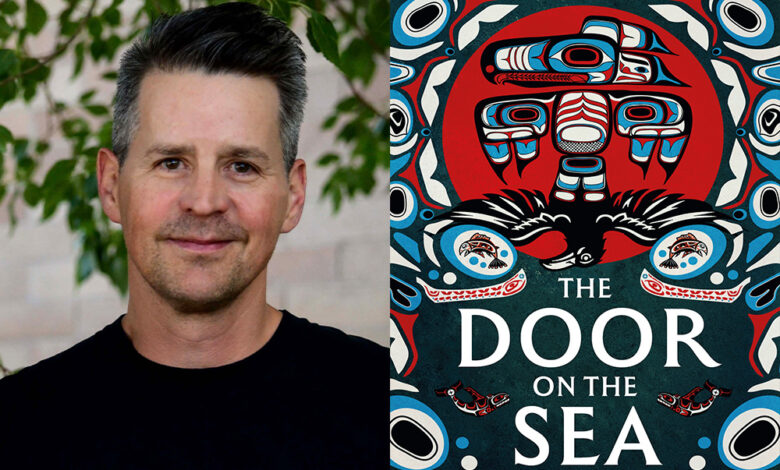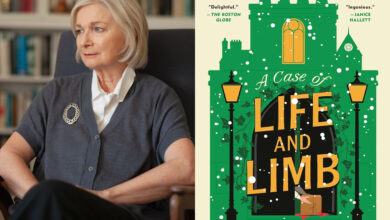Q&A: Caskey Russell, Author of ‘The Door on the Sea’

We chat with author Caskey Russell about The Door on the Sea, which is an epic quest fantasy debut that is the Tlingit indigenous response to The Lord of the Rings.
Hi, Caskey! Can you tell our readers a bit about yourself?
I was born and raised in Washington State, but have lived a lot of other places (one of my favs being New Zealand). I feel most at home when I’m in the mountains or out on the ocean. I’m a member of the Tlingit Tribe of Alaska and I was lucky enough to have Tlingit language speakers in my family growing up, so I got to hear a bit of the language as a kid (a lot of native tribes have very few native language speakers left). I have two grown boys and a large extended family who I’m very close to. As for work, I am currently a professor at the same university from which I graduated many years ago—Western Washington University. I teach in Fairhaven College, which is a college where students their own majors. I teach poetry and songwriting.
When did you first discover your love for writing and stories?
I learned to play guitar in high school and soon discovered I loved writing song lyrics to go along with the music I created on guitar. I was in college when I first tried writing stories, and I fell in love immediately with the world building aspect of fiction. I was a terrible writer, of course, when I started. But I kept at it and got better.
Quick lightning round! Tell us:
- The first book you ever remember reading: Kävik The Wolf Dog by Walt Morley, maybe when I was in 2nd
- The one that made you want to become an author: Probably something by Charles Dickens—David Copperfield or Oliver Twist or Great Expectations. I went through a Dickens phase in my late teens and early twenties where I loved how he plotted his narratives. I think one of his novels inspired me.
- The one that you can’t stop thinking about: Please don’t limit me to only one! I think about books all the time. One book I always think about: Tracks by Louise Erdrich.
Your debut novel, The Door on the Sea, is out now! If you could only describe it in five words, what would they be?
Adventures of would-be Tlingit warrior
What can readers expect?
I’ve taken shapeshifting characters from Tlingit oral tradition known as the Kooshdakáa and made them the mysterious villians of the novel. They’re determined to destroy and enslave the indigenous peoples of Éil’, the world of the novel. The Kooshdakáa can shapeshift into one’s dead relatives, which makes them hard to defeat.
Where did the inspiration for The Door on the Sea come from?
I was living in New Zealand when my two boys were young, and they were terribly homesick for the States. Every night they would cry when I put them to bed and demand we move back to America. The only thing that consoled them was taking them to see the movie The Hobbit, which had just come out in theaters and had been filmed in New Zealand (the set of Hobbiton was not too far from where we lived). We also bought all of the Lord of the Rings DVDs, which they watched incessantly. I can remember wishing my boys were as fanatic about stories from Tlingit oral tradition, which I’d often recite to them at bedtime. Sometime around the second week in New Zealand I had an epiphany: why don’t I start writing a Tolkien-like tale based on Tlingit tradition to read to them at night? Maybe that will dry their tears.
So the next day I wrote a few pages and read it to them that night. They loved it and wanted to be characters in the story. My oldest son wanted to be an armored wolf (he had a stuffed animal wolf he’d brought to New Zealand), my youngest son wanted to be a middle-aged warrior for some reason (I think he liked Aragorn in Lord of the Rings). I wrote their characters into the novel which, it seems, made them feel that they were now in control of the narrative. After every nightly reading they were full of suggestions and ideas about where the narrative should go. I took notes of their suggestions and have incorporated a number of their ideas into the novel.
Were there any moments or characters you really enjoyed writing or exploring?
I loved writing the character of Raven. You can see in Raven’s character, especially in the opening chapters of the novel, a father trying to make his two young sons laugh during their nightly readings. As a kid, I always loved hearing of Raven’s antics when my grandmother told me Raven Stories from Tlingit oral tradition. The stories often bordered on what the western world would consider obscene and scatological, and Raven was often a contrarian whose contrarian nature backfired in humorous ways. I was trying to capture Raven’s contrarian zaniness in the novel in hopes of making my boys crack up.
Did you face any challenges whilst writing? How did you overcome them?
The major challenge I faced in writing the novel had to do with how historically accurate to Tlingit tradition I should attempt to be. I wrestled with that question for a while and then decided to purposely not worry about historical authenticity or accuracy. I would create a completely fictional world, I would use Tlingit words and concepts and a few characters from oral tradition, but I wouldn’t use traditional stories (or even the name Tlingit) and I would place the narrative in an alternate universe rather than pre-contact Alaska. Once I made this determination, the challenge was resolved—I could have weapons, objects, food, people, places etc. in the narrative that were not part of the traditional Tlingit world.
What’s next for you?
The Door on the Sea is the first book in a trilogy called The Raven and Eagle Series, all of which will be published by Solaris. I have finished the second book, which is titled The Eagle in the Mountain, and am working on book three.
Lastly, what books have you enjoyed reading this year? Are there any you’re looking forward to picking up in 2026?
This past year? That’s a long time—I’d have to go back and check my library history and my bookshelves. But, since the end of the summer (August) I’ve read Babel by R.F. Kuang; Station Eleven by Emily St. John Mandel; The Glass Hotel by Emily St. John Mandel; The Lies of Locke Lamora by Scott Lynch; Red Seas Under Red Skies by Scott Lynch, and reread Fahrenheit 451 by Ray Bradbury.
I’m currently reading Saint Death’s Daughter by C.S.E. Cooney, and in 2026 I’m looking forward to picking up Katabasis by R.F. Kuang, The Buffalo Hunter Hunter by Stephen Graham Jones, and to finally getting around to The Sparrow by Mary Doria Russell.
Will you be picking up The Door on the Sea? Tell us in the comments below!
Source link




